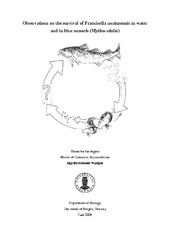| dc.contributor.author | Wangen, Ingvild Helland | eng |
| dc.date.accessioned | 2009-10-22T16:39:01Z | |
| dc.date.available | 2009-10-22T16:39:01Z | |
| dc.date.issued | 2009-06-09 | eng |
| dc.date.submitted | 2009-06-09 | eng |
| dc.identifier.uri | http://hdl.handle.net/1956/3565 | |
| dc.description.abstract | Francisellosis was discovered in farmed Atlantic cod (Gadus morhua) in the western parts of Norway in 2004. The bacterium Francisella noatunensis was identified as the causative agent. Today, francisellosis is known as one of the most severe diseases affecting farmed cod, and it has resulted in great economical losses for the industry. The knowledge on mechanisms involved in the spreading of the pathogen is scarce; however transmission has been shown by experimental cohabitation. Vertical transmission may also be possible, as F. noatunensis have been detected in cod eggs and in farmed juveniles. The bacteria have been detected in a number of wild fish species, in blue mussels (Mytilus edulis) and edible crab (Cancer pagurus). In the present study, four experiments were conducted in order to increase the knowledge concerning survival of F. noatunensis in freshwater and seawater at different temperatures, and the potential role blue mussels' play in spreading of the bacterium. The results indicate that both temperature and salinity have an impact on the culturability of F. noatunensis. Whether the bacteria are dead or have entered a viable but non culturable state, could not be determined, hence further research is needed to verify this state in F. noatunensis and its significance. Francisella noatunensis was rapidly filtered by the blue mussel and transported to the digestive diverticulae. The bacteria passed through the entire digestive system, and experiments showed that they were alive and infective in faeces shed by blue mussels. The mussels are thus clearly not capable of killing all F. noatunensis which pass through the digestive system. A cohabitation experiment with cod and blue mussels' previously exposed to F. noatunensis did not lead to infection in cod; hence the role as a reservoir seems unlikely. Further, no evidence suggesting that the bacteria are capable of persisting and multiplying in the mussel tissues was found. Bacterial clearance from the mussels was relatively fast, however faeces particles with live and infective bacteria may be passed on to the next trophic level. | en_US |
| dc.description.abstract | Francisellosis was discovered in farmed Atlantic cod (Gadus morhua) in the western parts of Norway in 2004. The bacterium Francisella noatunensis was identified as the causative agent. Today, francisellosis is known as one of the most severe diseases affecting farmed cod, and it has resulted in great economical losses for the industry. The knowledge on mechanisms involved in the spreading of the pathogen is scarce; however transmission has been shown by experimental cohabitation. Vertical transmission may also be possible, as F. noatunensis have been detected in cod eggs and in farmed juveniles. The bacteria have been detected in a number of wild fish species, in blue mussels (Mytilus edulis) and edible crab (Cancer pagurus). In the present study, four experiments were conducted in order to increase the knowledge concerning survival of F. noatunensis in freshwater and seawater at different temperatures, and the potential role blue mussels' play in spreading of the bacterium. The results indicate that both temperature and salinity have an impact on the culturability of F. noatunensis. Whether the bacteria are dead or have entered a viable but non culturable state, could not be determined, hence further research is needed to verify this state in F. noatunensis and its significance. Francisella noatunensis was rapidly filtered by the blue mussel and transported to the digestive diverticulae. The bacteria passed through the entire digestive system, and experiments showed that they were alive and infective in faeces shed by blue mussels. The mussels are thus clearly not capable of killing all F. noatunensis which pass through the digestive system. A cohabitation experiment with cod and blue mussels' previously exposed to F. noatunensis did not lead to infection in cod; hence the role as a reservoir seems unlikely. Further, no evidence suggesting that the bacteria are capable of persisting and multiplying in the mussel tissues was found. Bacterial clearance from the mussels was relatively fast, however faeces particles with live and infective bacteria may be passed on to the next trophic level. | en_US |
| dc.format.extent | 4021981 bytes | eng |
| dc.format.mimetype | application/pdf | eng |
| dc.language.iso | eng | eng |
| dc.publisher | The University of Bergen | en_US |
| dc.subject | Francisella noatunensis | eng |
| dc.subject | Francisella piscicida | eng |
| dc.subject | Survival | eng |
| dc.subject | Water | eng |
| dc.subject | Blue mussel | eng |
| dc.title | Observation on the survival of Francisella noatunensis in water and in blue mussel (Mytilus edulis) | en_US |
| dc.type | Master thesis | |
| dc.rights.holder | The author | en_US |
| dc.rights.holder | Copyright the author. All rights reserved | en_US |
| dc.description.degree | Master i Fiskehelse | en_US |
| dc.description.localcode | MAMN-FISK | |
| dc.description.localcode | FISKL | |
| dc.subject.nus | 759906 | eng |
| fs.subjectcode | FISKL | |
